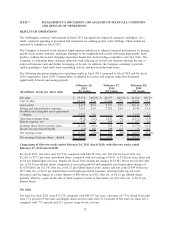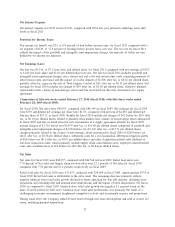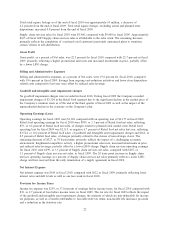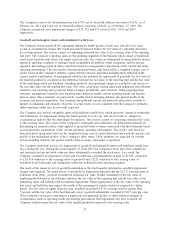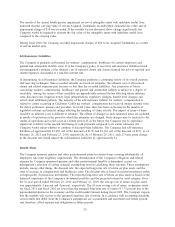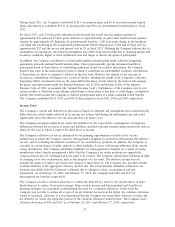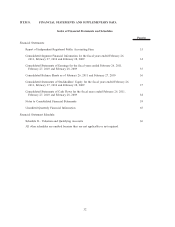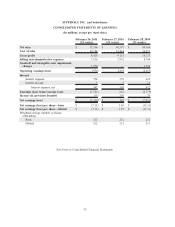Albertsons 2011 Annual Report Download - page 29
Download and view the complete annual report
Please find page 29 of the 2011 Albertsons annual report below. You can navigate through the pages in the report by either clicking on the pages listed below, or by using the keyword search tool below to find specific information within the annual report.The Company’s reserve for closed properties was $178, net of estimated sublease recoveries of $142, as of
February 26, 2011 and $128, net of estimated sublease recoveries of $125, as of February 27, 2010. The
Company recognized asset impairment charges of $39, $52 and $75 in fiscal 2011, 2010 and 2009,
respectively.
Goodwill and Intangible Assets with Indefinite Useful Lives
The Company reviews goodwill for impairment during the fourth quarter of each year, and also if an event
occurs or circumstances change that would more-likely-than-not reduce the fair value of a reporting unit below
its carrying amount. The reviews consist of comparing estimated fair value to the carrying value at the reporting
unit level. The Company’s reporting units are the operating segments of the business which consist of traditional
retail stores, hard-discount stores, and supply chain services. Fair values are determined by using both the market
approach, applying a multiple of earnings based on guideline for publicly traded companies, and the income
approach, discounting projected future cash flows based on management’s expectations of the current and future
operating environment. The rates used to discount projected future cash flows reflect a weighted average cost of
capital based on the Company’s industry, capital structure and risk premiums including those reflected in the
current market capitalization. If management identifies the potential for impairment of goodwill, the fair value of
the implied goodwill is calculated as the difference between the fair value of the reporting unit and the fair value
of the underlying assets and liabilities, excluding goodwill. An impairment charge is recorded for any excess of
the carrying value over the implied fair value. Fair value calculations contain significant judgments and estimates
related to each reporting unit’s projected future revenues, profitability and cash flows. When preparing these
estimates, management considers each reporting unit’s historical results, current operating trends and specific
plans in place. These estimates are impacted by variable factors including inflation, the general health of the
economy and market competition. The Company has sufficient current and historical information available to
support its judgments and estimates. However, if actual results are not consistent with the Company’s estimates,
future operating results may be materially impacted.
The Company also reviews intangible assets with indefinite useful lives, which primarily consist of trademarks
and tradenames, for impairment during the fourth quarter of each year, and also if events or changes in
circumstances indicate that the asset might be impaired. The reviews consist of comparing estimated fair value
to the carrying value. Fair values of the Company’s trademarks and tradenames are determined primarily by
discounting an assumed royalty value applied to projected future revenues associated with the tradename based
on management’s expectations of the current and future operating environment. The royalty cash flows are
then discounted using rates based on the weighted average cost of capital discussed above and the specific risk
profile of the tradenames relative to the Company’s other assets. These estimates are impacted by variable
factors including inflation, the general health of the economy and market competition.
The Company undertook reviews for impairment of goodwill and intangible assets with indefinite useful lives
twice during the year. During the second quarter of fiscal 2011 the Company’s stock price had a significant
and sustained decline and book value per share substantially exceeded the stock price. As a result, the
Company completed an impairment review and recorded non-cash impairment charges of $1,840, comprised
of a $1,619 reduction to the carrying value of goodwill and a $221 reduction to the carrying value of
indefinite-lived trademarks and tradenames within the traditional retail operating segment.
The result of the annual review of goodwill undertaken in the fourth quarter indicated no goodwill impairment
charges were required. The initial review of goodwill for impairment indicated that the $1,137 carrying value of
traditional retail stores’ goodwill exceeded its estimated fair value. Further assessment of the fair value of
implied goodwill based on the difference between the fair value of the reporting unit and the fair value of the
underlying assets and liabilities did not indicate impairment. Future appreciation of the fair value of the reporting
unit assets and liabilities may impact the results of the assessment if similar analysis is required in a future
period. The fair value of supply chain services’ goodwill exceeded its $710 carrying value by greater than
5 percent and the fair value of the hard-discount stores’ goodwill substantially exceeded its $137 carrying value.
If the Company’s stock price experiences a significant and sustained decline, or other events or changes in
circumstances, such as operating results not meeting plan indicate that impairment may have occurred, the
Company would reassess the fair value of the implied goodwill compared to the carrying value.
25






